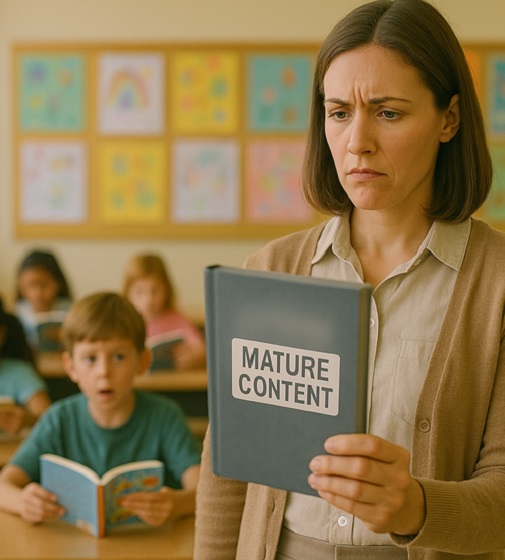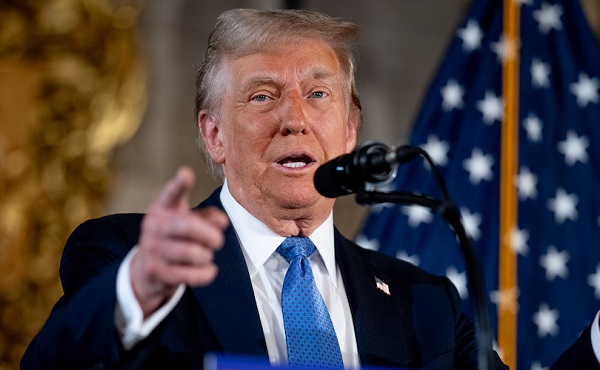Brownstone Institute
Justice Is Served: Jay Bhattacharya Chosen to Be NIH Director

Martin Kulldorff, Sunetra Gupta, Jay Bhattacharya. Authors of the Great Barrington Declaration
From the Brownstone Institute
By
“At some point in summer of 2020, I decided—what is my career for? If it’s just to have another CV line or a stamp, I’ve wasted my life—that I would speak no matter what the consequences were.”
Many years ago, I was at the wedding of a good friend, a guy who everyone seemed to like. He was/is humble, considerate, kind, and down to earth. I remember telling his mother while at the wedding that I would tell anyone that, “If you don’t like him, then the problem is you.”
I also feel that way about Stanford health economist Jay Bhattacharya. Jay’s nomination by President-elect Trump to be Director of the National Institutes of Health has been a long time coming and is a hopeful signal that national health research policy is headed in the right direction.
Jay was right about all the big things during the Covid pandemic and was an important counter to the destructive hubris of lockdown and mandate-promoting public health leaders and scientists in the US. Along with Martin Kulldorff and Sunetra Gupta, Jay took enormous personal and professional risks in drafting the Great Barrington Declaration in October of 2020. In response to the highly age-stratified mortality of Covid-19 and with the threat of serious collateral damage of continuing lockdowns, school closures, and mandates, the GBD instead promoted the policy of focused protection for vulnerable elderly and infirm people while allowing young and healthy people to live their lives.
The virus was going to infect everyone eventually and establish herd immunity, and there was no evidence that a vaccine (none approved at the time) would stop that natural process. The big question was how to deal with a natural disaster without making the situation much worse. Thus, the debate was focused protection versus unfocused protection—sheltering everyone regardless of their risk of mortality or serious disease until the entire population could be vaccinated with a vaccine of unknown efficacy and net benefit.
At least that’s the debate that should’ve happened. Unfortunately, it didn’t. Jay and his GBD coauthors were attacked, threatened, and slandered. When Jay’s research group published a study showing that the seroprevalence of Covid-19 in Santa Clara County in California was much higher than previously believed, it destroyed the delusion that the virus could be eliminated, that containment was at all possible. Many people didn’t want to hear that, and Jay was subjected to numerous attacks in the media, including a defamatory article in BuzzFeed claiming he was funded by dark money and implied he used questionable methods because he was biased toward the study’s outcome.
The fact that he shortly thereafter authored a paper showing very low seroprevalence in Major League Baseball franchises wasn’t enough to prove his objectivity. The message put forth by the public health establishment would simply not allow any dissent or debate. The policy needed to drive The Science™, and lower-case science could not be allowed to drive the policy.
I signed the Great Barrington Declaration the day it was published on October 4th, 2020. I had seen, and was greatly impressed by, interviews of Jay by Peter Robinson in March and April of 2020 and was heartened by Jay’s calm display of knowledge and humility. Jay described in one of these interviews the uncertainty surrounding the number of people infected and the claims being made by experts like Anthony Fauci regarding the infection fatality rate:
They don’t know it and I don’t know it. We should be honest about that. And we should be honest about that with people who make these policy decisions when making them. In a sense, people plug the worst case into their models, they project two to four million deaths, the newspapers pick up the two to four million deaths, the politicians have to respond, and the scientific basis for that projection…there’s no study underlying that scientific projection.
When asked about the potential for collateral damage to lockdowns, “It’s not dollars versus lives, it’s lives versus lives.” An understanding of the responsibility to avoid collateral harm of lockdowns was essential yet was in extremely short supply. Jay was attacked for this nuanced message. He got emails from colleagues and administrators telling him that questioning the high infection fatality rate was irresponsible. Yet, someone had to do it. However, the interviews went viral, because Jay gave millions of people something they didn’t have and desperately needed. He gave them hope.
As the year went on, Jay became the face of the opposition to unfocused protection, appearing in countless interviews and writing countless articles. He became an advisor to Florida Governor Ron DeSantis, who vowed to not lock down the people of Florida again after an initial wave of closures. When waves of Covid inevitably hit Florida, Stanford students papered the campus with pictures of Jay next to Florida death rates, implying Jay’s nuanced message was responsible for the deaths of thousands of people. When the age-adjusted mortality rate of Florida ended up being rather average compared to other states, including lockdown and mandate-happy California, no one apologized.
YouTube censored a public forum with Jay and Martin Kulldorff and Governor DeSantis, where they made claims about the hazards of continuous lockdowns, school closures, and mandates that months before wouldn’t have been at all controversial. After the GBD was published, Jay and Martin were invited to the White House by Covid advisor Scott Atlas to discuss the idea of focused protection with President Trump. Despite that meeting, the political battle continued to be an uphill fight.
The response of federal officials was shameful. Fauci and White House Covid Advisor Deborah Birx boycotted the meeting. Then NIH Director Francis Collins called for a “swift and devastating takedown” of the GBD’s premise and called the authors “fringe epidemiologists.” There simply was no appetite at the highest levels for a nuanced message or any debate whatsoever. Media coverage of Jay and other Covid response critics continued to be toxic.
Yet Jay’s appearances and message continued to inspire millions of people and give them hope. I began writing in support of focused protection and against the constant doom-saying that was harming everyone, especially children. I met Jay in the fall of 2021 because of my writing, at a conference organized by Brownstone Institute. “I think we are making a difference,” he said after shaking my hand. Like many other people he had inspired to take a stance against Covid hysteria, I needed to hear that.
The next day, Jay was preparing to give his speech in front of a small crowd in the ballroom, and I sat next to him while he reviewed his notes during the previous speaker’s talk. Although he was dressed in a suit and tie, when glancing down, I noticed Jay had a hole in his dress shoe. This truly wasn’t about money or even status. He was simply doing what he believed was morally right.
Later on, Jay helped spearhead a couple of Covid-related projects I was also involved in (I was there largely due to his influence). First was the Norfolk Group, which produced a resource document for the US Congress titled “Questions for a COVID-19 Commission” and the second was Florida’s Public Health Integrity Committee formed by Governor DeSantis and led by Florida Surgeon General Joe Ladapo. Both groups attempted to bring accountability for the US public health response, and I believe they were successful in spotlighting just how wrong and harmful lockdowns and mandates were for the very public they were supposed to help.
During the initial Norfolk Group meeting, Jay often talked about the moment of no return, “crossing the Rubicon,” as he put it, the moment that each one of us made a conscientious decision to stand up against the mob. He later recalled in an interview with Jordan Peterson: “At some point in summer of 2020, I decided—what is my career for? If it’s just to have another CV line or a stamp, I’ve wasted my life—that I would speak no matter what the consequences were.”
The world has benefitted from Jay’s crossing of the Rubicon. His nomination, after years in the wilderness and on the “fringe” of public health and health policy, restores a sense that there is in fact justice in the world. Now he moves on to the significant task of reforming health research policy. We should be cheering him on all the way.
And if you don’t like Jay, then the problem is you.
Republished from the author’s Substack
Author
Brownstone Institute
Net Zero: The Mystery of the Falling Fertility

From the Brownstone Institute
By
If you want to argue that a mysterious factor X is responsible for the drop in fertility, you will have to explain (1) why the factor affected only the vaccinated, and (2) why it started affecting them at about the time of vaccination.
In January 2022, the number of children born in the Czech Republic suddenly decreased by about 10%. By the end of 2022, it had become clear that this was a signal: All the monthly numbers of newborns were mysteriously low.
In April 2023, I wrote a piece for a Czech investigative platform InFakta and suggested that this unexpected phenomenon might be connected to the aggressive vaccination campaign that had started approximately 9 months before the drop in natality. Denik N – a Czech equivalent of the New York Times – immediately came forward with a “devastating takedown” of my article, labeled me a liar and claimed that the pattern can be explained by demographics: There were fewer women in the population and they were getting older.
To compare fertility across countries (and time), the so-called Total Fertility Rate (TFR) is used. Roughly speaking, it is the average number of children that are born to a woman over her lifetime. TFR is independent of the number of women and of their age structure. Figure 1 below shows the evolution of TFR in several European countries between 2001 and 2023. I selected countries that experienced a similar drop in TFR in 2022 as the Czech Republic.

So, by the end of 2023, the following two points were clear:
- The drop in natality in the Czech Republic in 2022 could not be explained by demographic factors. Total fertility rate – which is independent of the number of women and their age structure – dropped sharply in 2022 and has been decreasing ever since. The data for 2024 show that the Czech TFR has decreased further to 1.37.
- Many other European countries experienced the same dramatic and unexpected decrease in fertility that started at the beginning of 2022. I have selected some of them for Figure 1 but there are more: The Netherlands, Norway, Slovakia, Slovenia, and Sweden. On the other hand, there are some countries that do not show a sudden drop in TFR, but rather a steady decline over a longer period (e.g. Belgium, France, UK, Greece, or Italy). Notable exceptions are Bulgaria, Spain, and Portugal where fertility has increased (albeit from very low numbers). The Human Fertility Project database has all the numbers.
This data pattern is so amazing and unexpected that even the mainstream media in Europe cannot avoid the problem completely. From time to time, talking heads with many academic titles appear and push one of the politically correct narratives: It’s Putin! (Spoiler alert: The war started in February 2022; however, children not born in 2022 were not conceived in 2021). It’s the inflation caused by Putin! (Sorry, that was even later). It’s the demographics! (Nope, see above, TFR is independent of the demographics).
Thus, the “v” word keeps creeping back into people’s minds and the Web’s Wild West is ripe with speculation. We decided not to speculate but to wrestle some more data from the Czech government. For many months, we were trying to acquire the number of newborns in each month, broken down by age and vaccination status of the mother. The post-socialist health-care system of our country is a double-edged sword: On one hand, the state collects much more data about citizens than an American would believe. On the other hand, we have an equivalent of the FOIA, and we are not afraid to use it. After many months of fruitless correspondence with the authorities, we turned to Jitka Chalankova – a Czech Ron Johnson in skirts – who finally managed to obtain an invaluable data sheet.
To my knowledge, the datasheet (now publicly available with an English translation here) is the only officially released dataset containing a breakdown of newborns by the Covid-19 vaccination status of the mother. We requested much more detailed data, but this is all we got. The data contains the number of births per month between January 2021 and December 2023 given by women (aged 18-39) who were vaccinated, i.e., had received at least one Covid vaccine dose by the date of delivery, and by women who were unvaccinated, i.e., had not received any dose of any Covid vaccine by the date of delivery.
Furthermore, the numbers of births per month by women vaccinated by one or more doses during pregnancy were provided. This enabled us to estimate the number of women who were vaccinated before conception. Then, we used open data on the Czech population structure by age, and open data on Covid vaccination by day, sex, and age.
Combining these three datasets, we were able to estimate the rates of successful conceptions (i.e., conceptions that led to births nine months later) by preconception vaccination status of the mother. Those interested in the technical details of the procedure may read Methods in the newly released paper. It is worth mentioning that the paper had been rejected without review in six high-ranking scientific journals. In Figure 2, we reprint the main finding of our analysis.

Figure 2 reveals several interesting patterns that I list here in order of importance:
- Vaccinated women conceived about a third fewer children than would be expected from their share of the population. Unvaccinated women conceived at about the same rate as all women before the pandemic. Thus, a strong association between Covid vaccination status and successful conceptions has been established.
- In the second half of 2021, there was a peak in the rate of conceptions of the unvaccinated (and a corresponding trough in the vaccinated). This points to rather intelligent behavior of Czech women, who – contrary to the official advice – probably avoided vaccination if they wanted to get pregnant. This concentrated the pregnancies in the unvaccinated group and produced the peak.
- In the first half of 2021, there was significant uncertainty in the estimates of the conception rates. The lower estimate of the conception rate in the vaccinated was produced by assuming that all women vaccinated (by at least one dose) during pregnancy were unvaccinated before conception. This was almost certainly true in the first half of 2021 because the vaccines were not available prior to 2021. The upper estimate was produced by assuming that all women vaccinated (by at least one dose) during pregnancy also received at least one dose before conception. This was probably closer to the truth in the second part of 2021. Thus, we think that the true conception rates for the vaccinated start close to the lower bound in early 2021 and end close to the upper bound in early 2022. Once again, we would like to be much more precise, but we have to work with what we have got.
Now that the association between Covid-19 vaccination and lower rates of conception has been established, the one important question looms: Is this association causal? In other words, did the Covid-19 vaccines really prevent women from getting pregnant?
The guardians of the official narrative brush off our findings and say that the difference is easily explained by confounding: The vaccinated tend to be older, more educated, city-dwelling, more climate change aware…you name it. That all may well be true, but in early 2022, the TFR of the whole population dropped sharply and has been decreasing ever since.
So, something must have happened in the spring of 2021. Had the population of women just spontaneously separated into two groups – rednecks who wanted kids and didn’t want the jab, and city slickers who didn’t want kids and wanted the jab – the fertility rate of the unvaccinated would indeed be much higher than that of the vaccinated. In that respect, such a selection bias could explain the observed pattern. However, had this been true, the total TFR of the whole population would have remained constant.
But this is not what happened. For some reason, the TFR of the whole population jumped down in January 2022 and has been decreasing ever since. And we have just shown that, for some reason, this decrease in fertility affected only the vaccinated. So, if you want to argue that a mysterious factor X is responsible for the drop in fertility, you will have to explain (1) why the factor affected only the vaccinated, and (2) why it started affecting them at about the time of vaccination. That is a tall order. Mr. Occam and I both think that X = the vaccine is the simplest explanation.
What really puzzles me is the continuation of the trend. If the vaccines really prevented conception, shouldn’t the effect have been transient? It’s been more than three years since the mass vaccination event, but fertility rates still keep falling. If this trend continues for another five years, we may as well stop arguing about pensions, defense spending, healthcare reform, and education – because we are done.
We are in the middle of what may be the biggest fertility crisis in the history of mankind. The reason for the collapse in fertility is not known. The governments of many European countries have the data that would unlock the mystery. Yet, it seems that no one wants to know.
Author
Brownstone Institute
FDA Exposed: Hundreds of Drugs Approved without Proof They Work

From the Brownstone Institute
By
The US Food and Drug Administration (FDA) has approved hundreds of drugs without proof that they work—and in some cases, despite evidence that they cause harm.
That’s the finding of a blistering two-year investigation by medical journalists Jeanne Lenzer and Shannon Brownlee, published by The Lever.
Reviewing more than 400 drug approvals between 2013 and 2022, the authors found the agency repeatedly ignored its own scientific standards.
One expert put it bluntly—the FDA’s threshold for evidence “can’t go any lower because it’s already in the dirt.”
A System Built on Weak Evidence
The findings were damning—73% of drugs approved by the FDA during the study period failed to meet all four basic criteria for demonstrating “substantial evidence” of effectiveness.
Those four criteria—presence of a control group, replication in two well-conducted trials, blinding of participants and investigators, and the use of clinical endpoints like symptom relief or extended survival—are supposed to be the bedrock of drug evaluation.
Yet only 28% of drugs met all four criteria—40 drugs met none.
These aren’t obscure technicalities—they are the most basic safeguards to protect patients from ineffective or dangerous treatments.
But under political and industry pressure, the FDA has increasingly abandoned them in favour of speed and so-called “regulatory flexibility.”
Since the early 1990s, the agency has relied heavily on expedited pathways that fast-track drugs to market.
In theory, this balances urgency with scientific rigour. In practice, it has flipped the process. Companies can now get drugs approved before proving that they work, with the promise of follow-up trials later.
But, as Lenzer and Brownlee revealed, “Nearly half of the required follow-up studies are never completed—and those that are often fail to show the drugs work, even while they remain on the market.”
“This represents a seismic shift in FDA regulation that has been quietly accomplished with virtually no awareness by doctors or the public,” they added.
More than half the approvals examined relied on preliminary data—not solid evidence that patients lived longer, felt better, or functioned more effectively.
And even when follow-up studies are conducted, many rely on the same flawed surrogate measures rather than hard clinical outcomes.
The result: a regulatory system where the FDA no longer acts as a gatekeeper—but as a passive observer.
Cancer Drugs: High Stakes, Low Standards
Nowhere is this failure more visible than in oncology.
Only 3 out of 123 cancer drugs approved between 2013 and 2022 met all four of the FDA’s basic scientific standards.
Most—81%—were approved based on surrogate endpoints like tumour shrinkage, without any evidence that they improved survival or quality of life.
Take Copiktra, for example—a drug approved in 2018 for blood cancers. The FDA gave it the green light based on improved “progression-free survival,” a measure of how long a tumour stays stable.
But a review of post-marketing data showed that patients taking Copiktra died 11 months earlier than those on a comparator drug.
It took six years after those studies showed the drug reduced patients’ survival for the FDA to warn the public that Copiktra should not be used as a first- or second-line treatment for certain types of leukaemia and lymphoma, citing “an increased risk of treatment-related mortality.”
Elmiron: Ineffective, Dangerous—And Still on the Market
Another striking case is Elmiron, approved in 1996 for interstitial cystitis—a painful bladder condition.
The FDA authorized it based on “close to zero data,” on the condition that the company conduct a follow-up study to determine whether it actually worked.
That study wasn’t completed for 18 years—and when it was, it showed Elmiron was no better than placebo.
In the meantime, hundreds of patients suffered vision loss or blindness. Others were hospitalized with colitis. Some died.
Yet Elmiron is still on the market today. Doctors continue to prescribe it.
“Hundreds of thousands of patients have been exposed to the drug, and the American Urological Association lists it as the only FDA-approved medication for interstitial cystitis,” Lenzer and Brownlee reported.
“Dangling Approvals” and Regulatory Paralysis
The FDA even has a term—”dangling approvals”—for drugs that remain on the market despite failed or missing follow-up trials.
One notorious case is Avastin, approved in 2008 for metastatic breast cancer.
It was fast-tracked, again, based on ‘progression-free survival.’ But after five clinical trials showed no improvement in overall survival—and raised serious safety concerns—the FDA moved to revoke its approval for metastatic breast cancer.
The backlash was intense.
Drug companies and patient advocacy groups launched a campaign to keep Avastin on the market. FDA staff received violent threats. Police were posted outside the agency’s building.
The fallout was so severe that for more than two decades afterwards, the FDA did not initiate another involuntary drug withdrawal in the face of industry opposition.
Billions Wasted, Thousands Harmed
Between 2018 and 2021, US taxpayers—through Medicare and Medicaid—paid $18 billion for drugs approved under the condition that follow-up studies would be conducted. Many never were.
The cost in lives is even higher.
A 2015 study found that 86% of cancer drugs approved between 2008 and 2012 based on surrogate outcomes showed no evidence that they helped patients live longer.
An estimated 128,000 Americans die each year from the effects of properly prescribed medications—excluding opioid overdoses. That’s more than all deaths from illegal drugs combined.
A 2024 analysis by Danish physician Peter Gøtzsche found that adverse effects from prescription medicines now rank among the top three causes of death globally.
Doctors Misled by the Drug Labels
Despite the scale of the problem, most patients—and most doctors—have no idea.
A 2016 survey published in JAMA asked practising physicians a simple question—what does FDA approval actually mean?
Only 6% got it right.
The rest assumed that it meant the drug had shown clear, clinically meaningful benefits—such as helping patients live longer or feel better—and that the data was statistically sound.
But the FDA requires none of that.
Drugs can be approved based on a single small study, a surrogate endpoint, or marginal statistical findings. Labels are often based on limited data, yet many doctors take them at face value.
Harvard researcher Aaron Kesselheim, who led the survey, said the results were “disappointing, but not entirely surprising,” noting that few doctors are taught about how the FDA’s regulatory process actually works.
Instead, physicians often rely on labels, marketing, or assumptions—believing that if the FDA has authorized a drug, it must be both safe and effective.
But as The Lever investigation shows, that is not a safe assumption.
And without that knowledge, even well-meaning physicians may prescribe drugs that do little good—and cause real harm.
Who Is the FDA Working for?
In interviews with more than 100 experts, patients, and former regulators, Lenzer and Brownlee found widespread concern that the FDA has lost its way.
Many pointed to the agency’s dependence on industry money. A BMJ investigation in 2022 found that user fees now fund two-thirds of the FDA’s drug review budget—raising serious questions about independence.

Yale physician and regulatory expert Reshma Ramachandran said the system is in urgent need of reform.
“We need an agency that’s independent from the industry it regulates and that uses high-quality science to assess the safety and efficacy of new drugs,” she told The Lever. “Without that, we might as well go back to the days of snake oil and patent medicines.”
For now, patients remain unwitting participants in a vast, unspoken experiment—taking drugs that may never have been properly tested, trusting a regulator that too often fails to protect them.
And as Lenzer and Brownlee conclude, that trust is increasingly misplaced.
- Investigative report by Jeanne Lenzer and Shannon Brownlee at The Lever [link]
- Searchable public drug approval database [link]
- See my talk: Failure of Drug Regulation: Declining standards and institutional corruption
Republished from the author’s Substack
-

 International2 days ago
International2 days agoSecret Service suspends six agents nearly a year after Trump assassination attempt
-

 Bruce Dowbiggin2 days ago
Bruce Dowbiggin2 days agoThe Covid 19 Disaster: When Do We Get The Apologies?
-

 Crime23 hours ago
Crime23 hours agoSweeping Boston Indictment Points to Vast Chinese Narco-Smuggling and Illegal Alien Labor Plot via Mexican Border
-

 Alberta1 day ago
Alberta1 day agoAlberta school boards required to meet new standards for school library materials with regard to sexual content
-

 Automotive2 days ago
Automotive2 days agoAmerica’s EV Industry Must Now Compete On A Level Playing Field
-

 Environment24 hours ago
Environment24 hours agoEPA releases report on chemtrails, climate manipulation
-

 Business13 hours ago
Business13 hours agoTrump slaps Brazil with tariffs over social media censorship
-

 Business2 days ago
Business2 days ago‘Experts’ Warned Free Markets Would Ruin Argentina — Looks Like They Were Dead Wrong






